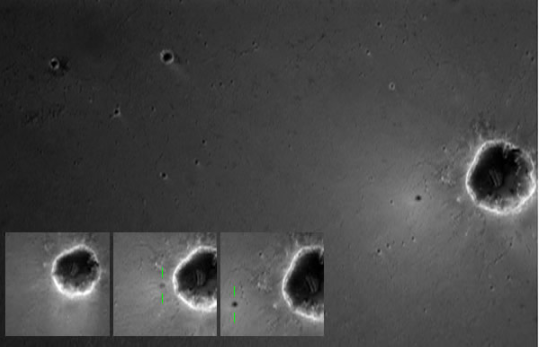Martian Opposition Effect
The Martian Opposition Effect: Exploring Atmospheric Optics on Another Planet
When the Mars Exploration Rover 'Opportunity' descended towards Meridiani Planum on January 24, 2004, it captured a remarkable image that showcased an intriguing phenomenon known as the Martian Opposition Effect. This effect occurs when sunlight hits the surface of Mars at a specific angle, causing a shadow to be cast by objects on the planet's arid surface. The image taken from an altitude of only 1400m revealed a dark circle to the left of a bright-rimmed crater, marking the parachute's shadow. However, what made this image truly fascinating was the bright area surrounding the shadow, which was a result of the opposition effect caused by shadow hiding by Martian soil grains and backscattering effects.
The opposition effect is a captivating atmospheric optics phenomenon that has been observed on Earth and now, for the first time, on another planet. It occurs when light is scattered and reflected in a way that enhances the brightness of a surface when viewed directly opposite the light source. In the case of Mars, this effect is particularly pronounced due to the unique properties of its atmosphere and terrain.
So, how does the Martian opposition effect actually work? Here are some key factors to consider:
-
Shadow Hiding: Martian soil grains have the ability to hide shadows cast by objects on the surface. When sunlight hits these grains at a specific angle, they can scatter and reflect light in a way that diminishes the visibility of shadows. This phenomenon contributes to the bright area surrounding the parachute shadow in the image captured by Opportunity.
-
Backscattering Effects: Backscattering refers to the scattering of light in the opposite direction of its original path. On Mars, this phenomenon plays a significant role in enhancing the brightness of surfaces during opposition. When sunlight hits the Martian soil grains at certain angles, they scatter light back towards the observer, intensifying the overall brightness of the scene.
-
Unique Atmospheric Conditions: Mars has a thin atmosphere compared to Earth, consisting mostly of carbon dioxide. This composition, combined with the planet's dusty surface, allows for increased scattering and reflection of light. These atmospheric conditions amplify the opposition effect, making it more pronounced than what we typically observe on our own planet.
The discovery of the Martian opposition effect provides valuable insights into the behavior of light in extraterrestrial environments. It highlights the complexities of atmospheric optics and demonstrates how even subtle variations in atmospheric composition and surface characteristics can result in visually striking phenomena.
The implications of this discovery extend beyond mere curiosity. Understanding the behavior of light on Mars helps scientists interpret images captured by rovers and landers, enabling them to gain a clearer understanding of the planet's surface features, geological processes, and even potential signs of past or present life.
In conclusion, the Martian opposition effect is a captivating atmospheric optics phenomenon that showcases the interplay between sunlight, Martian soil grains, and the planet's thin atmosphere. The shadow hiding and backscattering effects combine to create a bright area surrounding shadows cast on the Martian surface. This discovery not only expands our knowledge of atmospheric optics but also provides valuable insights into the unique characteristics of Mars' atmosphere and terrain. As we continue to explore the Red Planet, further observations and studies of the Martian opposition effect will undoubtedly deepen our understanding of this intriguing phenomenon and its implications for planetary science.

Images NASA/JPL
As the Mars Exploration Rover 'Opportunity' descended towards Meridiani Planum on Jan 24, 2004 its parachute cast a shadow on the arid Martian surface.
The large image (PIA05146) was taken from an altitude of only 1400m and shows an area about 1.2km (3/4 mile) across.
The parachute shadow is the dark circle to the left of the bright rimmed crater at far right. The moving shadow is marked in two of the inset pictures.
Surrounding the shadow is a bright area - an opposition effect caused by shadow hiding by Martian soil grains and backscattering effects.
This image is possibly the first showing an "Atmospheric Optics" effect on another planet. It was spotted by Hugo Landheer (site) of the Netherlands.
Note: this article has been automatically converted from the old site and may not appear as intended. You can find the original article here.
Reference Atmospheric Optics
If you use any of the definitions, information, or data presented on Atmospheric Optics, please copy the link or reference below to properly credit us as the reference source. Thank you!
-
<a href="https://atoptics.co.uk/blog/martian-opposition-effect/">Martian Opposition Effect</a>
-
"Martian Opposition Effect". Atmospheric Optics. Accessed on December 23, 2024. https://atoptics.co.uk/blog/martian-opposition-effect/.
-
"Martian Opposition Effect". Atmospheric Optics, https://atoptics.co.uk/blog/martian-opposition-effect/. Accessed 23 December, 2024
-
Martian Opposition Effect. Atmospheric Optics. Retrieved from https://atoptics.co.uk/blog/martian-opposition-effect/.